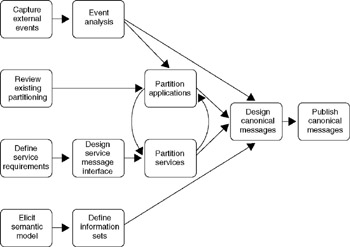Enterprise Message Model
The solution is not to start with the existing Application Programming Interfaces (APIs) or data model, which is the path of least resistance. The solution is to begin at the center with a model of the shared interaction, independent of the current implementation. The techniques to do this mostly follow from the elicitation techniques described in Chapter 9, with a few variations. Figure 12.2 shows an outline of an approach to this task. Space doesn't permit an exhaustive treatment of all the steps, but they should be self-evident. The approach shares with the more general semantic modeling approach the idea of building a semantic model of the concepts to be addressed. Where it differs is in the emphasis on business events, as these will generally translate into messages that will track between the systems, and in the recognition that some of the messages are there to accommodate the fact that the business has been split into application areas, which generate some of the need for messages.

Figure 12.2: Message modeling methodology.
Part of this analysis, again in the area of event analysis, is to look at the potential traffic from partner companies (B2B opportunities and existing relationships). To be consistent, these will need to be translated into messages and fed through this approach. The "canonical message" in Figure 12.2 refers to the creation of an authoritative version of a particular message, rather than letting each application project and each system integration project define its own.
EAN: 2147483647
Pages: 184